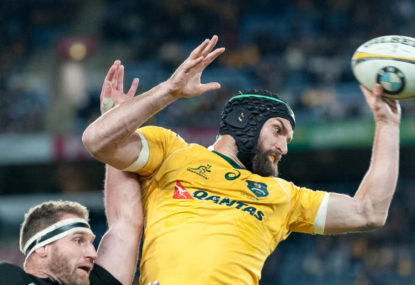Ball Handling 101
new author
Roar Rookie

With all the debate going on about the balance of the Wallabies back row, it is becoming increasingly important to have a holistic view of the forward pack and not just the back row itself, but how it works in tandem with the second row.
It is not uncommon to see versatile forwards in the mould of Scott Fardy and Lopeti Timani capable of fulfilling the role of second and back-row forwards.
Let’s lay out the general roles of each position:
#4. Second row: lineout prowess, physically imposing, more abrasive than technical
#5. Second row: lineout prowess, high work-rate, often the lineout caller
#6. Blindside flanker: lineout prowess, gain-line running, rucking competency
#7. Openside flanker: rucking excellency, high work-rate
#8. Number eight: gain-line running, physically imposing, rucking competency
Without getting too technical, of the two second rowers, one is a better hitman. In the back row, your 7 is your jackal, your 8 is your gain-line runner, and your 6 can do a bit of both.
Australia’s back five looks a bit like this:
Rob Simmons: a lineout-focused second rower
Adam Coleman: a very physical player
Dean Mumm: a lineout-focused back rower with strong work rate
Michael Hooper: high work-rate, dynamic, and a reasonably capable jackal
David Pocock: very capable jackal, albeit out of form recently
Interestingly, in the Argentina and South Africa Tests, Coleman has been calling the lineout; fulfilling the role of both second rowers. A long-term complementary partner for him has yet to be found.
Mumm is not very dynamic, however he makes up with value in the lineout and general work rate. Fardy is similar, however has added value of a reasonable ability in the rucks.
Hooper makes metres, scores tries and has been able to force turnovers and penalties at an above-average yet unsatisfactory rate for a traditional #7. A better runner in space than in tight, Pocock is – when in form – focused on the rucks.
Thus the Wallabies lack a gain-line, crash-ball runner, which should ideally be the number 8. There is a favour of work-rate, bean-pole players such as Simmons and Mumm, who offer stability but tend to stagnate the forward pack somewhat. This player should really only be a second rower or number 6, and only one of these.
Let’s examine the New Zealand back five:
Brodie Retallick: a physical player who is also capable at lineout
Sam Whitelock: lineout specialist
Jerome Kaino: hitman, aggressive in attack and defence
Sam Cane: ruck-focused player
Kieran Read: x-factor, wide running player
The All Blacks have better balance. Read plays like a traditional, wide-running 6, and Kaino like a traditional, gain-line 8. Retallick and Whitelock are aggressive and technical locks.
This leads to the question, does the number on your back really matter? The only time it really controls you is at the scrum, and even this is less important for the back rowers than the second rowers.
Considering the injuries we now have at hand, I would select: Fardy, Coleman, Sean McMahon, Hooper and Timani.
Fardy could slot into the second row, having played there before. Mumm could do the same thing, but we have much more dynamic players available.
This choice would give us access to two ‘hitmen’ in order to balance the wide-running of Hooper. Having Fardy and Hooper in the side, two decent jackals, would balance not having the specialist Pocock.
And the lineout wouldn’t suffer, with Fardy, Coleman, McMahon and Timani all capable jumpers.